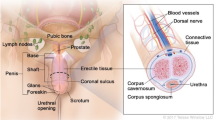Abstract
Purpose
To obtain insight into demographical factors, histology and survival rates of females diagnosed with primary urethral cancer and to determine favourable treatment.
Methods
Data from 91 females with primary urethral carcinoma, age varying from 15 to 85 years, registered between 1989 and 2008 at the National Cancer Registry of the Netherlands were used for this study. Demographical factors, incidence rate, morphology and tumour stage according to TNM classification were analysed. Kaplan–Meier survival curves were constructed and stratified by stage, histological type and treatment modality.
Results
The overall crude annual incidence was 0.7 per million women with a peak incidence in the age group of 80–84 years. Analysis of the morphology showed urothelial cell carcinoma (UCC) in 45 %, squamous cell carcinoma (SCC) in 19 %, adenocarcinoma (AC) in 29 %, and unknown or undifferentiated carcinoma accounted for 6 %. Almost half of patients (46 %) had advanced disease at time of diagnosis and was mainly treated with surgery and/or radiotherapy. The 5-year survival rates of stage 0–II, stage III and stage IV were 67, 53 and 17 %, respectively. The 5-year survival rates of SCC, UCC and AC were 64, 61 and 31 %, respectively.
Conclusions
Female primary urethral carcinoma is a rare condition, and the majority of patients were aged above 65 years. Almost half of patients have advanced disease upon diagnosis. TNM stage and histological type of disease are the most determining factors for survival. Extended surgery with or without radiotherapy seems to be the most favourable treatment. Awareness and early diagnosis are important to improve survival.


Similar content being viewed by others
Abbreviations
- SCC:
-
Squamous cell carcinoma
- UCC:
-
Urothelial cell carcinoma
- AC:
-
Adenocarcinoma
- undiffC:
-
Undifferentiated carcinoma
- HPV:
-
Human papilloma virus
- MRI:
-
Magnetic resonance imaging
- CT:
-
Computerized tomography
- KM-curve:
-
Kaplan–Meier curve
References
Swartz MA, Porter MP, Lin DW et al (2006) Incidence of primary urethral carcinoma in the United States. Urology 68:1164–1168
Dalbagni G, Zhang ZF, Lacombe L (1998) Female urethral carcinoma: an analysis of treatment outcome and a plea for standardized management strategy. Br J Urol 82:835–841
Grabstald H, Hilaris B, Henschke U (1966) Cancer of the female urethra. JAMA 197:835–842
Hahn P, Krepart G, Malaker K (1991) Carcinoma of female urethra. Manitoba experience: 1958–1987. Urology 37:106–109
Touijer AK, Dalbagni G (2004) Role of voided urine cytology in diagnosing primary urethral carcinoma. Urology 63:33–35
Nurenberg P, Zimmern PE (1997) Role of MR imaging with transrectal coil in the evaluation of complex urethral abnormalities. AJR 169:1335–1338
Gerrard ER, Lloyd LK, Kubricht WS et al (2003) Transvaginal ultrasound for the diagnosis of urethral diverticulum. J Urol 169:1395–1397
Hosseinzadeh K, Furlan A, Torabi M (2008) Pre- and postoperative evaluation of a urethral diverticulum. AJR 190:165–172
Meis JM, Ayala AG, Johnson DE (1987) Adenocarcinoma of the urethra in women. A clinicopathologic study. Cancer 60:1038–1052
Collado A, Algaba F, Caparrós J et al (2000) Clear cell adenocarcinoma in a female urethral diverticulum. Scand J Urol Nephrol 34:136–138
Maier U, Dorfinger K, Susani M (1998) Clear cell adenocarcinoma of the female urethra. J Urol 160:492–493
Drew PA, Murphy WM, Civentos F, Speights VO et al (1996) The histogenesis of clear cell adenocarcinoma of the lower urinary tract. Case series and review of the literature. Hum Pathol 27:248–252
Wiener JS, Walther PJ (1994) A high association of onocogenic human papillomaviruses with carcinomas of the female urethra: polymerase chain reaction, best analysis of multiple histological types. J Urol 151:49–53
Shigehara K, Sasagawa T, Kawaguchi S et al (2010) Prevelance of human papilloma virus infection in the urinary tract of men with urethritis. Int J Urol 17(6):563–568
Hampl M, Deckers-Figel S, Hampl JA et al (2008) New aspects of vulvar cancer: changes in localization and age of onset. Gynecol Oncol 109(3):340–345
Sun K, Huan Y, Unger PD (2008) Clear cell adenocarcinoma of urinary bladder and urethra: another urinary tract lesion, immunoreactive for P504S. Arch Pathol Lab Med 132(9):1417–14122
Dimarco DS, Dimarco CS, Zincke H et al (2004) Surgical treatment for local control of female urethral carcinoma. Urol Oncol 22:404–409
Foens CS, Hussey DH, Staples JJ (1991) A comparison of the roles of surgery and radiation therapy in the management of carcinoma of the female urethra. Int J Radiat Oncol Biol Phys 21:961–968
Kuettel MR, Parda DS, Harter KW et al (1997) Treatment of female urethral carcinoma in medically inoperable patients using external beam irradiation and high dose rate intracavitary brachytherapy. J Urol 157:1669–1671
Sailer SL, Shipley WU, Wang CC (1988) Carcinoma of the female urethra: a review of results with radiation therapy. J Urol 140:1–5
Licht MR, Klein EA, Bukowski R et al (1995) Combination radiation and chemotherapy for the treatment of squamous cell carcinoma of the male and female urethra. J Urol 153:1918–1920
Schouten LJ, Hoppener P, Van den Brandt PA et al (1993) Completeness of cancer registration in Limburg, the Netherlands. Int J Epidemiol 22:369–376
Parkin DM, Whelan SL, Ferlay J et al (1997) Cancer incidence in five continents. International Agency for Research on Cancer, Lyon
Van der Sanden GAC, Coebergh JWW, Schouten LJ et al (1995) Cancer incidence in the Netherlands in 1989 and 1990: first results of the nationwide Netherlands Cancer Registry. Eur J Cancer 31:1822–1829
Green FL, Page DL, Flemming ID et al (2002) AJCC cancer staging manual. American Joint Committee On Cancer. American Cancer Society, 6th edn. Springer, New York
Narayan P, Konety B (1992) Surgical treatment of female urethral carcinoma. Urol Clin N Am 19:373–382
Conflict of interest
The authors declare that they have no conflict of interest.
Author information
Authors and Affiliations
Corresponding author
Rights and permissions
About this article
Cite this article
Derksen, J.W., Visser, O., de la Rivière, G.B. et al. Primary urethral carcinoma in females: an epidemiologic study on demographical factors, histological types, tumour stage and survival. World J Urol 31, 147–153 (2013). https://doi.org/10.1007/s00345-012-0882-5
Received:
Accepted:
Published:
Issue Date:
DOI: https://doi.org/10.1007/s00345-012-0882-5




